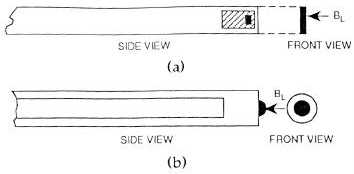T.O. 33B-1-1
3-30
procedures to indicate magnetic-field direction and to measure both applied and residual fields. One limitation is that
it measures only the flux passing through the probe or sensor (Figure 3-23) and does not measure the field at or below
the part surface.
a) Tangential
b) Normal
(The arrow represents an external magnetic leakage field BL at the point of measurement.)
Figure 3-23. Hall-Effect Sensors.
3.3.9.3.2
Quantitative Quality Indicator (QQI).
The QQI is a small, thin, metal shim, made of a low carbon steel, that contains artificial defects for establishing or
verifying MPI techniques. Examples of QQIs are illustrated in Figure 3-24. The artificial defects are formed by an
etching process that can produce very narrow (0.005 inch) flaws with tightly controlled depths, typically 15%, 30% and
60% of a QQI’s thickness. The thickness is either 0.002 or 0.004 inch. The basic QQI shim satisfies most needs
because its circular and crossed-bar flaw configuration is suitable for longitudinal and circular fields. The bars in the
cross are 0.25 inch long, while the circular slot is 0.5 inch in diameter. The circular flaw is especially useful in
balancing multi-directional fields. The miniature shim is designed for small areas on a test part; each circle is 0.25
inch in diameter. The QQI with three concentric circular flaws with different depths (typically 20%, 30% and 40% of
shim thickness) may be used for more quantitative assessment of a magnetic field; the diameters of the circles are 0.25,
0.375 and 0.5 inch in diameter. The linear shim is 2 inches long by 0.4 inch wide; it may useful in covering a curved
area of a part, such as a radius.
Figure 3-24. Shim-Type Magnetic Flux Indicators
3.3.9.3.2.1
QQIs are intended for use with the continuous method only. If a Gauss/Tesla meter is available, readings for both
circular and longitudinal fields can be made at the point of QQI attachment. Once the readings are recorded for a part,
it may be quicker to use the meter instead of a QQI to ensure sufficient field strength when the same type of part is
inspected later.
3.3.9.3.2.2 Advantages of the QQI.
a. Only device able to demonstrate adequacy and balance of multidirectional magnetization.



